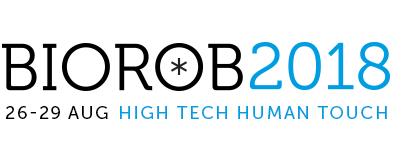Workshop 1: Novel bioinspired actuator designs for robotics (BioAct)
Organizers: Maziar Ahmad Sharbafi, Tom Verstraten, Peter P. Pott, Philipp Beckerle, and Andre Seyfarth
Timeslot: 9:30 – 16:30
Room: Carré 2G
Website: http://lauflabor.ifs-tud.de/doku.php?id=home:bioact
Event goals and objectives:
The objective of the workshop is to give an overview of the state of the art in bioinspired (e.g., compliant) actuation, discuss the practical implementation of such actuators, and brainstorm how bio-inspiration could bring these actuators and the robots in which they are implemented to new levels of versatility, agility, and energy-efficiency. This workshop is composed of 4 sessions focusing on the following goals:
- Recent research on biological actuators (what can we learn from biology?)
- Variable impedance actuators and series/parallel compliance and their relation to biology
- State of the art of engineered actuators mimicking muscle behaviours
- Application of the bioinspired actuators in robots and assistive devices.
Abstract:
Through evolution, muscles have been optimized to generate and fine-tune motions. They provide highly versatile force sources, i.e., they have an extremely low impedance (perfectly back-drivable), provide functional damping and low stiction. Although their bandwidth is limited, it is sufficient for even highly dynamic human/animal locomotion. Some biological principles can be applied to robotics, e.g., the addition of compliance to traditional rigid actuators. Elastic actuators can increase safety in human-robot interaction, improve energy efficiency, reduce impacts and augment performance in dynamic tasks. While such actuators have been researched extensively over the past two decades, there are still various open questions. These relate to the fundamental properties mentioned above, but also to their implementation and control as well as the integration of their hard- and software. Elastic actuators have been applied in wearable robotic devices, rehabilitation robots and humanoid robots. In the last years, bio-inspired approaches have brought the capabilities of elastic actuators closer to those of the human muscle, e.g., by introducing redundancy to mimic the muscle fibre recruitment. Another level of redundancy can be achieved by employing mono- and bi-articular actuators to achieve designs with increased robustness and simplified control. We plan to divide the workshop in four sessions comprising three talks of around 20 minutes. At the end of each second session, there will be an extensive discussion (around 45 minutes) between participants and speakers of the two sessions. There will be live demonstrations during the talks and in the subsequent discussion. Besides the invited talks and discussion, the organizers will call for posters to be presented at the workshop.
Speakers and Agenda:
The workshop consists of 4 sessions. It reaches from research on understanding actuation mechanism in biological locomotor systems to application of the bioinspired actuators on robots and assistive devices as follows:
Session 1: Recent research on biological actuation – what can we learn from biology?
In this session, we want to address the advantages of biological locomotor systems’ actuation, i.e., muscle mechanics and neuromuscular control.
The potential presentations are as follows:
1) Dynamical muscle behaviours (Christian Rode, Friedrich Scheller Universität Jena)
2) From spiking motor neurons to joint mechanics: perspectives for human-machine interaction (Massimo Sartori, University of Twente)
3) Resolving redundancies in human motor control at kinematic, motor, and neural level – biomechanical concepts and applications (Andre Seyfarth, TU Darmstadt)
Session 2: Variable impedance actuators and parallel compliance
In this session, we discuss how parallel compliance and the bio-inspired concept of variable stiffness can be implemented in actuators. Both mechanical design (passive compliance) and control (active compliance) are addressed.
1) Minimalistic design for compliant multi-DOF actuation (Heike Valery, TU Delft)
2) Lightweight, low-power electroadhesive clutches for biorobotic actuation (Steve Collins, Stanford University)
3) Elastic actuation in robotics and control (Sami Haddadin, Technische Universität München)
Session 3: State of the art of engineered actuators approaching muscle behaviours
In this session, we present an overview about the attempts to develop muscle-like actuators in engineering. We discuss how redundancy and morphology (e.g., using biarticular actuators) can enhance actuation performance.
1) Muscles are more than just force sources: examining system dynamics of muscle-like actuators (Joshua Schultz, University of Tulsa)
2) Attempts to develop artificial muscles (Koh Hosoda, Osaka University).
3) Hybrid actuator and redundancy to mimic biological locomotor actuation behaviour and improve energy efficiency (Maziar Sharbafi, TU Darmstadt & Tom Verstraten, Vrije Universiteit Brussel)
Session 4: Application of bioinspired actuators in robots and assistive devices.
And finally, we address the advantages of these actuation mechanisms in design and control of human friendly robots and assistive devices such as prostheses and exo skeletons:
1) Compliant actuation principles for rehabilitation and assistive robots (Dirk Lefeber, Vrije Universiteit Brussel).
2) Implementation of explosive compliant actuation in the AMPfoot prosthesis (Pierre Cherelle, Vrije Universiteit Brussel)
3) A parallel-elastic actuator for the Robo-Mate back-support exoskeleton (Stefano Toxiri, Istituto Italiano di Tecnologia (IIT))
Website: http://lauflabor.ifs-tud.de/doku.php?id=home:bioact
Call for Poster presentation
Extended abstract (2 pages max) following the IEEE RAS paper template for addressing workshop topics. An accompanying video is optional and can also be provided as a weblink (e.g., youtube).
All contributions must be sent as a pdf file to sharbafi@sport.tu-darmstadt.de
Accepted contributions will be allocated a spotlight talk at the end of session 2 and a poster presentation.
Important Dates
Submission Deadline: June 30th, 2018
Acceptance Notification: July 15th, 2018
